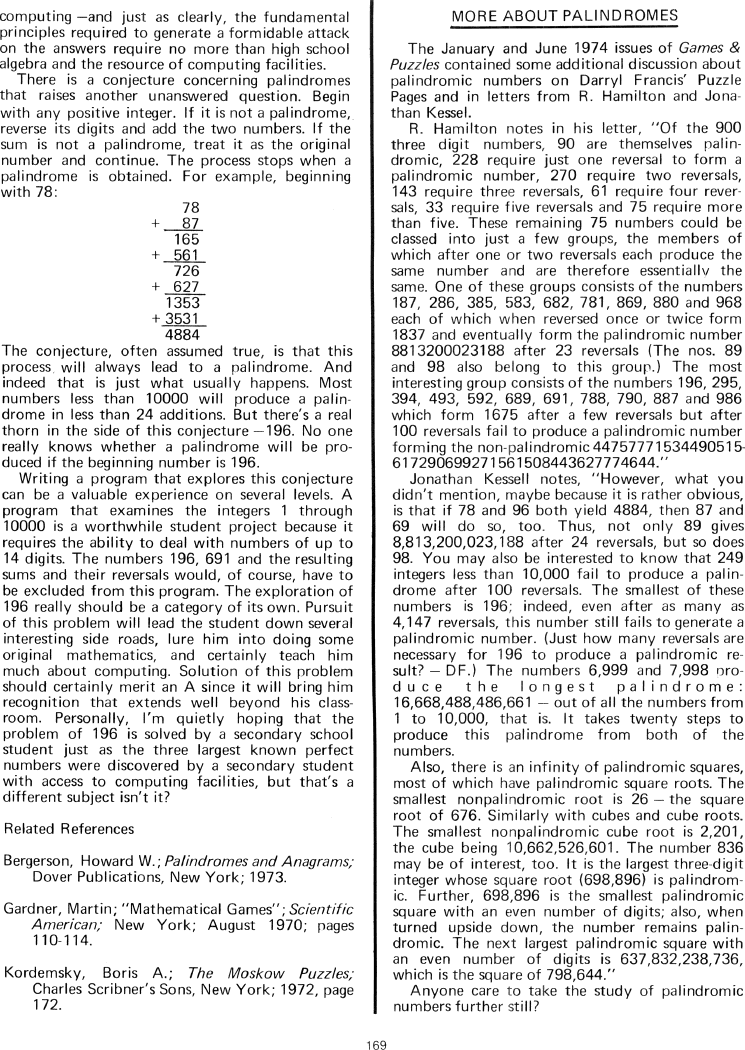The Best of Creative Computing Volume 1 (published 1976)
Palindromes: For Those Who Like to End at the Beginning (palindrome numbers, squares)

computing -and just as clearly, the fundamental principles required to generate
a formidable attack on the answers require no more than high school algebra and
the resource of computing facilities.
There is a conjecture concerning palindromes that raises another unanswered
question. Begin with any positive integer. If it is not a palindrome, reverse
its digits and add the two numbers. If the sum is not a palindrome, treat it as
the original number and continue. The process stops when a palindrome is
obtained. For example, beginning with 78:
78
+ 87
---165
+ 561
---726
+ 627
---1353
+ 3531
---4884
The conjecture, often assumed true, is that this process, will always lead to a
palindrome. And
indeed that is just what usually happens. Most numbers less than 10000 will
produce a palindrome in less than 24 additions. But there's a real thorn in the
side of this conjecture –196. No one really knows whether a palindrome will be
produced if the beginning number is 196.
Writing a program that explores this conjecture can be a valuable experience on
several levels. A program that examines the integers 1 through 10000 is a
worthwhile student project because it
requires the ability to deal with numbers of up to 14 digits. The numbers 196,
691 and the resulting
sums and their reversals would, of course, have to be excluded from this
program. The exploration of
196 really should be a category of its own. Pursuit of this problem will lead
the student down several
interesting side roads, lure him into doing some original mathematics, and
certainly teach him much about computing. Solution of this problem should
certainly merit an A since it will bring him recognition that extends well
beyond his classroom. Personally, I'm quietly hoping that the problem of 196 is
solved by a secondary school student just as the three largest known perfect
numbers were discovered by a secondary student with access to computing
facilities, but that's a different subject isn't it?
Related References
Bergerson, Howard W.; Palindromes and Anagrams; Dover Publications, New York;
1973.
Gardner, Martin; "Mathematical Games"; Scientific American; New York; August
1970; pages
110-114.
Kordemsky, Boris A.; The Moskow Puzzles; Charles Scribner's Sons, New York;
1972, page
172
MORE ABOUT PALINDROMES
The January and June 1974 issues of Games & Puzzles contained some additional
discussion about
palindromic numbers on Darryl Francis' Puzzle Pages and in letters from R.
Hamilton and Jonathan Kessel.
R. Hamilton notes in his letter, "Of the 900 three digit numbers, 90 are
themselves palindromic, 228 require just one reversal to form a palindromic
number, 270 require two reversals, 143 require three reversals, 61 require four
reversals, 33 require five reversals and 75 require more than five. These
remaining 75 numbers could be classed into just a few groups, the members of
which after one or two reversals each produce the same number and are therefore
essentially the same. One of these groups consists of the numbers 187, 286, 385,
583, 682, 781, 869, 880 and 968 each of which when reversed once or twice form
1837 and eventually form the palindromic number 8813200023188 after 23 reversals
(The nos. 89 and 98 also belong to this group.) The most interesting group
consists of the numbers 196, 295, 394, 493, 592, 689, 691, 788, 790, 887 and 986
which form 1675 after a few reversals but after 100 reversals fail to produce a
palindromic number forming the non-palindromic
44757771534490515617290699271561508443627774644."
Jonathan Kessell notes, "However, what you didn't mention, maybe because it is
rather obvious, is that if 78 and 96 both yield 4884, then 87 and 69 will do so,
too. Thus, not only 89 gives 8,813,200,023,188 after 24 reversals, but so does
98. You may also be interested to know that 249 integers less than 10,000 fail
to produce a palindrome after 100 reversals. The smallest of these numbers is
196; indeed, even after as many as 4,147 reversals, this number still fails to
generate a palindromic number. (Just how many reversals are necessary for 196 to
produce a palindromic result? - DF.) The numbers 6,999 and 7,998 produce the
longest palindrome: 16,668,488,486,661 – out of all the numbers from 1 to
10,000, that is. It takes twenty steps to produce this palindrome from both of
the numbers.
Also, there is an infinity of palindromic squares, most of which have
palindromic square roots. The
smallest nonpalindromic root is 26 – the square root of 676. Similarly with
cubes and cube roots. The smallest nonpalindromic cube root is 2,201, the cube
being 10,662,526,601. The number 836 may be of interest, too. It is the largest
three-digit integer whose square root (698,896) is palindromic. Further, 698,896
is the smallest palindromic square with an even number of digits; also, when
turned upside down, the number remains palindromic. The next largest palindromic
square with an even number of digits is 637,832,238,736, which is the square of
798,644."
Anyone care to take the study of palindromic numbers further still?


